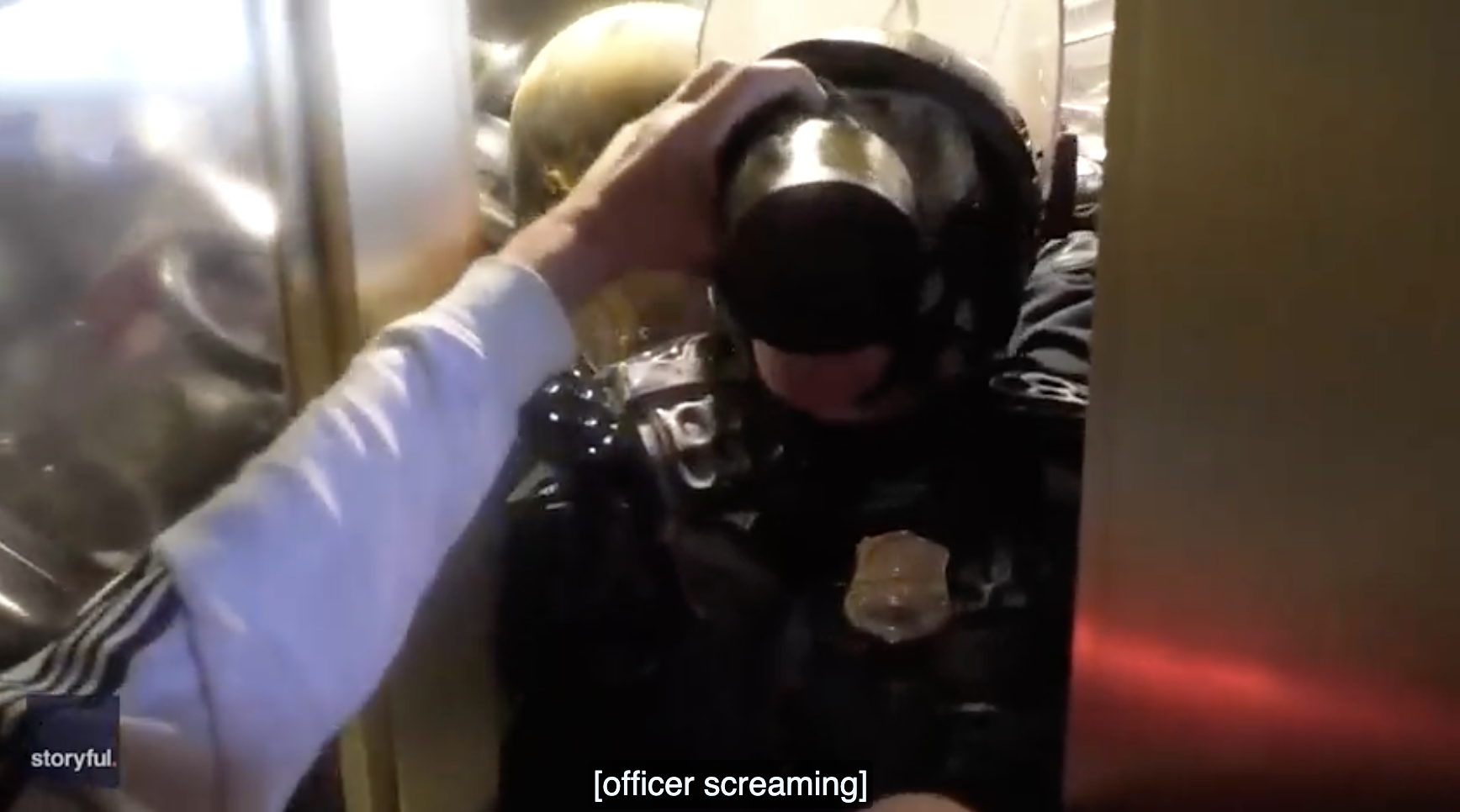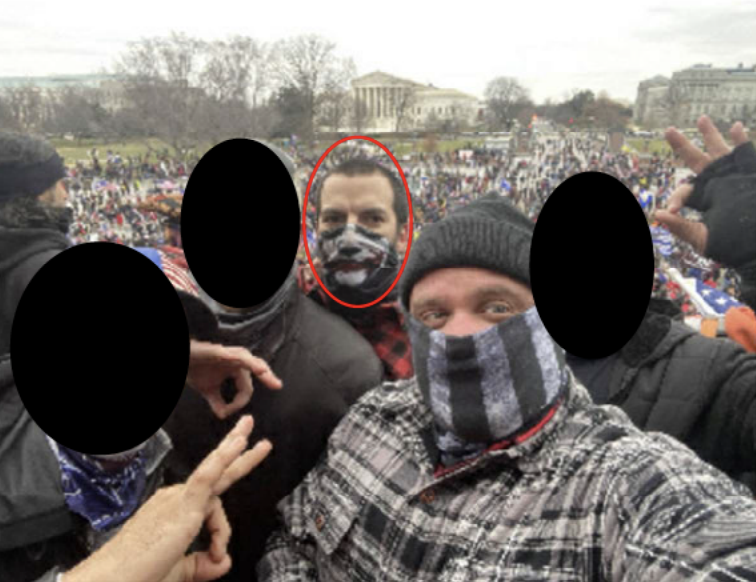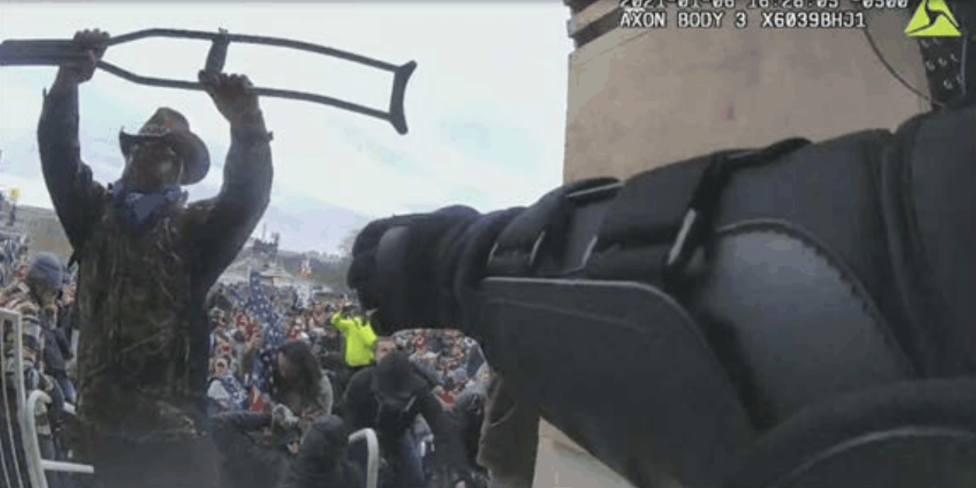Terrorists in the Tunnel: The Omnibus Indictment for Officer Daniel Hodge’s Assault
One of the most spectacular assaults from January 6 was that charged against Patrick McCaughey for crushing Officer Daniel Hodges in a door.
McCaughey was charged early — on January 19. Over time, though, his indictment has become more than that — an indictment incorporating the worst assailants involved in a long brutal fight that took place in the Lower West Terrace entrance to the Capitol, deemed the Tunnel. First Tristan Chandler Stevens was added in March. Christopher Quaglin and David Judd were added in April. Robert Morss and Geoffrey Sills were added in June.
On August 4, the government rolled out a superseding indictment that adds two newly charged defendants, Steven Cappuccio and David Mehaffie, and incorporates Freddie Klein into the existing one; it was unsealed yesterday after Cappuccio and Mehaffie were arrested.
A notice filed in both the McCaughey and Klein dockets on July 29 explains the logic of this indictment.
All nine of these individuals are or will be charged primarily with assaultive conduct on law enforcement officers in and around the first landing of the Lower West Terrace as well as the Lower West Terrace archway, colloquially referred to as “the tunnel,” of the United States Capitol Building on January 6, 2021, between approximately 1:00 p.m. and 4:30 p.m. This tunnel entranceway to the Capitol Building, which is approximately ten feet wide, was the site of a significant physical confrontation with law enforcement for several hours. Each of these defendants was an active participant in the first wave of rioters to enter the tunnel between 2:40 and 3:18 p.m., at which time law enforcement successfully cleared the tunnel of rioters for the first time that day. Moreover, several of the defendants, including Mr. Klein, committed additional crimes on the first landing of the Lower Wester Terrace before reaching the tunnel for the first time. Accordingly, because the primary criminal conduct alleged against these individuals overlaps both temporally and geographically, and the evidence against them will be mutually admissible, including the testimony of witnesses and their victims, the government is preparing to charge this group in a single indictment and to present evidence against them in a single trial.
The same notice says that while there are “dozens” of people who committed crimes along with these defendants, they do “not expect” to add any other defendants to this one.
I’ve tried to lay out which defendants got charged with what crimes using what weapons in this table. Altogether, I think this indictment does four different things.
First, Cappuccio is charged with grabbing Hodges’ gas mask and pulling if off and then stealing his police baton.
McCaughey is the guy whose name is on this indictment and who has, since the days after the riot, been one of the chief focal points because of that assault. But Cappuccio was actually the guy alleged to be doing to the most harm to Hodges (a point that McCaughey nodded to in a successful bid to get pretrial release). Cappuccio has finally been added alongside McCaughey, charged in one of the signature assaults of the attack.
Second, this indictment charges Mehaffie along with a bunch of people he gave instructions to during the hours long assaults, as captured by his Sedition Hunter moniker, Tunnel Commander and explained by HuffPo.
Dave Mehaffie of Dayton, Ohio, was known to online investigators as #TunnelCommander because he was issuing orders to members of the mob who were attacking officers during a brutal battle at the lower western terrace entrance to the Capitol. Mehaffie was 86-AFO on the FBI’s Capitol wanted list, meaning he was wanted for assault on a federal officer.
A judge signed an arrest warrant for Mehaffie on Aug. 4 after he was indicted by a grand jury as part of an existing case.
Mehaffie was involved in one of the toughest battles of the Capitol siege. Members of the mob had stormed past police barriers and ascended the scaffolding set up for President Joe Biden’s inauguration on Jan. 20, and were attempting to break into the building. During the “medieval” battle, members of the pro-Trump mob kidnapped D.C. Metropolitan Police Officer Michael Fanone, who was repeatedly electroshocked. Rosanne Boyland, a pro-Trump member of the mob, was trampled during the brutal clash. The woman’s brother-in-law said that former President Donald Trump “incited a riot” that killed one of his “biggest fans.”
Alone among these nine defendants, Mehaffie is not charged with assault using a dangerous weapon and/or directly striking the officer victim (that’s roughly speaking the difference between the 111(a)(1) charges and the 111(b) charges in the table). Instead, Mehaffie is charged with one count of assault and abetting assault, lasting from 2:40 to 3:18, presumably amounting to his directing the assaults of the others, along with civil disorder and obstruction. But that doesn’t convey the seriousness of his actions, because he had a role in making the other assaults more effective.
That’s why including him on this omnibus indictment will be important. By charging all nine men together, DOJ will be able to show how these men, who aren’t alleged to have known each other before the assault and aren’t charged with conspiracy, nevertheless worked in concert, always ensuring there were people at the front to press the assault, with Mehaffie playing a key role in making it all work (Morss, too, had a key role in directing traffic in the tunnel, which will also become clearer at trial with all charged together). In isolation, these men’s assaults can be minimized. In concert, their actions had a devastating effect.
Finally, Klein’s inclusion does more than just get him added to what will be a very powerful trial. He was originally indicted, on March 19, with just one count of assault. By April 5, in a detention memo, DOJ described three different assaults. So DOJ was bound to supersede his initial indictment in any case. This superseding indictment charges him in six different assaults (I think I’ve bolded the ones that appeared in the April detention memo), the culmination of seven months of video review to understand his role.
It also might get Klein detained. Of the seven men who had already been charged, Stevens was released on arrest, McCaughey got released with a huge bond payment, and Judd was released after review. The government successfully fought to keep Quaglin and Morss detained, sustaining Quaglin’s detention on appeal.
Klein also fought successfully for release. Along the way, his attorneys pointed to the conduct of McCaughey and two other of his now co-defendants, claiming they were more dangerous.
Contrast these cases, and the allegations against Mr. Klein, with others detained pretrial and alleged to have engaged in far more egregious conduct including having pinned an officer between a door and a riot shield (McCaughey – 21-cr-00040); violently assaulting an officer in the side of the neck with a riot shield and spraying chemical irritant directly into the eyes of an officer (Quaglin – 21-mj-00355); repeatedly throwing objects, including a pole, a desk drawer, some type of pipe/metal rod, and a flagpole at officers (Jenkins – 21-cr-00245); lighting and throwing fireworks at officers (Judd – 21-mj-00334), and striking an officer so violently with a pole that it shatters on his riot shield (Palmer – 21-mj-00301).
John Bates released Klein (in an opinion that significantly lowered the bar on releasing violent assault defendants). And while the release itself was a defensible decision, Bates’ logic (in my opinion) was not. Bates treated Klein’s assault on the Capitol, as a State Department official, as a breach of trust, but also credited him with having held a security clearance, as if having a cleared individual attack his own government isn’t particularly dangerous (as the government successfully argued in Timothy Hale-Cusanelli’s case). Crazier still, Bates said that Klein’s assaults weren’t as bad as others because his objective was not to injure the police but instead to occupy the tunnel, the use of violence for political end.
The government’s contention that Klein engaged in “what can only be described as hand-to-hand combat” for “approximately thirty minutes” also overstates what occurred. See Gov’t’s Br. at 6. Klein consistently positioned himself face-to-face with multiple officers and also repeatedly pressed a stolen riot shield against their bodies and shields. His objective, as far as the Court can tell, however, appeared to be to advance, or at times maintain, the mob’s position in the tunnel, and not to inflict injury. He is not charged with injuring anyone and, unlike with other defendants, the government does not submit that Klein intended to injure officers. Compare Hr’g Tr. 57:12–18 (government conceding that the evidence does not establish Klein intended to injure anyone, only that “there was a disregard of care whether he would injure anyone or not” in his attempt to enter the Capitol), with Gov’t’s Opp’n to Def.’s Mot. to Reopen Detention Hearing & For Release on Conditions, ECF No. 30 (“Gov’t’s Opp’n to McCaughey’s Release”), United States v. McCaughey, III, 21-CR-040-1, at 11 (D.D.C. Apr. 7, 2021) (government emphasizing defendant’s “intent to injure” an officer who he had pinned against a door using a stolen riot shield as grounds for pretrial detention). And during the time period before Klein obtained the riot shield, he made no attempts to “battle” or “fight” the officers with his bare hands or other objects, such as the flagpole he retrieved. That does not mean that Klein could not have caused serious injury— particularly given the chaotic and cramped atmosphere inside the tunnel. But his actions are distinguishable from other detained defendants charged under § 111(b) who clearly sought to incapacitate and injure members of law enforcement by striking them with fists, batons, baseball bats, poles, or other dangerous weapons.
[snip]
Klein’s conduct was forceful, relentless, and defiant, but his confrontations with law enforcement were considerably less violent than many others that day, and the record does not establish that he intended to injure others. [my emphasis]
Klein is now the co-defendant of McCaughey, Judd, and Quaglin, charged in more assaults than McCaughey and Judd, which might make his own prior comparison with them backfire. More importantly, Klein’s inclusion in this larger indictment makes it clear how his actions cannot be viewed — as Bates did — as isolation actions, but were instead an integral part of some of the worst clashes of the day.
I have no idea whether DOJ will use this superseding indictment to move to get Klein’s release revoked. But he’s on the edge anyway: since his release, he has had several release violations for things like drinking enough wine at dinner with his mom that he decided to just stay over the night in violation of curfew. Thus far, John Bates hasn’t deemed Klein’s disrespect for the authority of the Court to be worth detaining him over. Trevor McFadden, under whom Klein’s case will be moved, has similarly been reluctant to revoke bail (though the most notable January 6 defendant where he did revoke bail, Brandon Fellows, is only charged with obstruction and may have mental health issues contributing to his refusal to follow release conditions). But he has far less patience with defendants who openly disdain the Court’s authority, as Klein has.
Last week, I noted that the government had made a record that they are entitled to invoke a terrorist enhancement for Scott Fairlamb at sentencing (his sentencing has been bumped to November to give the probation office time to finish the presentencing memo).
Like Fairlamb, all these defendants are also charged with obstruction. If proven at trial, that would mean a jury found there was an intent behind their serial, extended, coordinated assaults: to occupy the Capitol (as even Judge Bates described it) and in so doing to halt the vote count. These men are accused of violence in the service of preventing the peaceful transfer of power. And as such, I would be shocked if on this most spectacular of assault trials, DOJ didn’t also go after a terrorism enhancement.
In his testimony before the January 6 Commission, Jamie Raskin asked Hodges why he referred to terrorism or terrorists 15 times. Hodges read the legal definition of domestic terrorism:
Activities that involve acts dangerous to human life that are a violation of the criminal laws of the United States or of any state, and, b, appear to be intended to intimidate or coerce a civilian population, or, to influence the policy of a government by intimidation or coercion.
If this omnibus case goes to trial it will demonstrate how all these assaults worked in concert to sustain an assault on our democracy for thirty-eight minutes. Officer Hodges may have his vindication at labeling these men terrorists.



